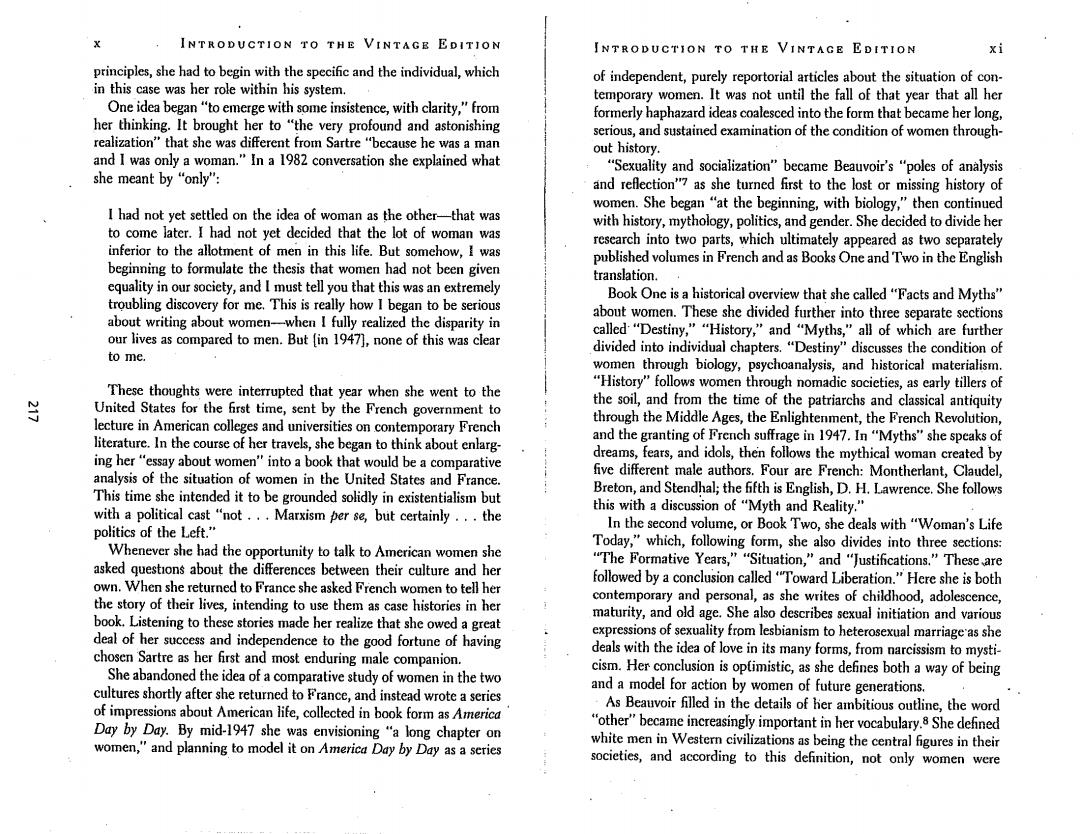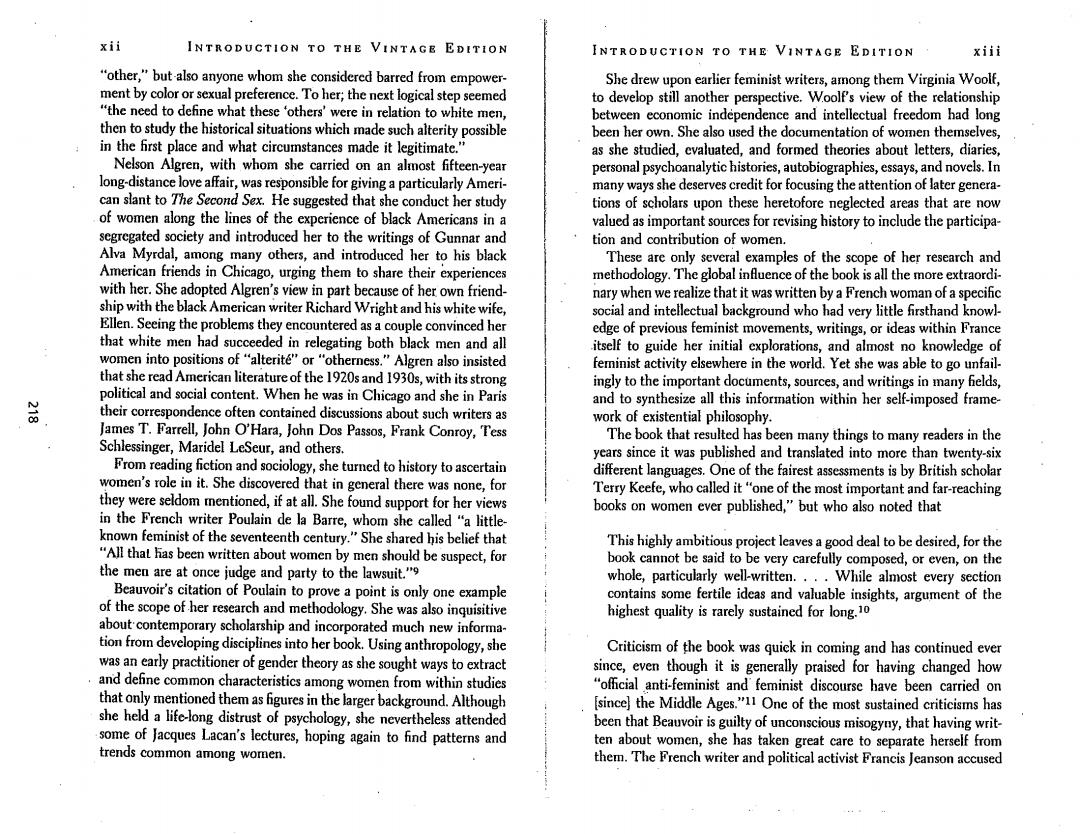
INTRODUCTION TO THE VINTAGE EDITION INTRODUCTION TO THE VINTAGE EDITION xi principles,she had to begin with the specific and the individual,which of independent,purely reportorial articles about the situation of con- in this case was her role within his system. temporary women.It was not until the fall of that year that all her One idea began "to emerge with some insistence,with clarity,"from formerly haphazard ideas coalesced into the form that became her long, her thinking.It brought her to "the very profound and astonishing serious,and sustained examination of the condition of women through- realization"that she was different from Sartre"because he was a man out history. and I was only a woman."In a 1982 conversation she explained what "Sexuality and socialization"became Beauvoir's"poles of analysis she meant by“only': and reflection"7 as she turned first to the lost or missing history of women.She began "at the beginning,with biology,"then continued I had not yet settled on the idea of woman as the other-that was with history,mythology,politics,and gender.She decided to divide her to come later.I had not yet decided that the lot of woman was inferior to the allotment of men in this life.But somehow,I was research into two parts,which ultimately appeared as two separately published volumes in French and as Books One and Two in the English beginning to formulate the thesis that women had not been given translation. equality in our society,and I must tell you that this was an extremely Book One is a historical overview that she called "Facts and Myths" troubling discovery for me.This is really how I began to be serious about writing about women-when I fully realized the disparity in about women.These she divided further into three separate sections our lives as compared to men.But [in 1947],none of this was clear called“Destiny,,”“"History,”and“Myths,”all of which are further divided into individual chapters."Destiny"discusses the condition of to me. women through biology,psychoanalysis,and historical materialism. These thoughts were interrupted that year when she went to the "History"follows women through nomadic societies,as early tillers of United States for the first time,sent by the French government to the soil,and from the time of the patriarchs and classical antiquity lecture in American colleges and universities on contemporary French through the Middle Ages,the Enlightenment,the French Revolution, literature.In the course of her travels,she began to think about enlarg- and the granting of French suffrage in 1947.In "Myths"she speaks of ing her"essay about women"into a book that would be a comparative dreams,fears,and idols,then follows the mythical woman created by analysis of the situation of women in the United States and France. five different male authors.Four are French:Montherlant,Claudel, This time she intended it to be grounded solidly in existentialism but Breton,and Stendhal;the fifth is English,D.H.Lawrence.She follows with a political cast "not...Marxism per se,but certainly...the this with a discussion of "Myth and Reality." politics of the Left." In the second volume,or Book Two,she deals with"Woman's Life Whenever she had the opportunity to talk to American women she Today,"which,following form,she also divides into three sections: asked questions about the differences between their culture and her u"The Formative Years,”“Situation,”and“lustifications,.”These are own.When she returned to France she asked French women to tell her followed by a conclusion called "Toward Liberation."Here she is both the story of their lives,intending to use them as case histories in her contemporary and personal,as she writes of childhood,adolescence, book.Listening to these stories made her realize that she owed a great maturity,and old age.She also describes sexual initiation and various deal of her success and independence to the good fortune of having expressions of sexuality from lesbianism to heterosexual marriage'as she chosen Sartre as her first and most enduring male companion. deals with the idea of love in its many forms,from narcissism to mysti- She abandoned the idea of a comparative study of women in the two cism.Her conclusion is optimistic,as she defines both a way of being cultures shortly after she returned to France,and instead wrote a series and a model for action by women of future generations. of impressions about American life,collected in book form as America As Beauvoir filled in the details of her ambitious outline,the word Day by Day.By mid-1947 she was envisioning "a long chapter on "other"became increasingly important in her vocabulary.8 She defined women,"and planning to model it on America Day by Day as a series white men in Western civilizations as being the central figures in their societies,and according to this definition,not only women were

xii INTRODUCTION TO THE VINTAGE EDITION INTRODUCTION TO THE VINTAGE EDITION xiii "other,"but -also anyone whom she considered barred from empower- She drew upon earlier feminist writers,among them Virginia Woolf, ment by color or sexual preference.To her;the next logical step seemed to develop still another perspective.Woolf's view of the relationship "the need to define what these 'others'were in relation to white men, between economic independence and intellectual freedom had long then to study the historical situations which made such alterity possible been her own.She also used the documentation of women themselves, in the first place and what circumstances made it legitimate." as she studied,evaluated,and formed theories about letters,diaries, Nelson Algren,with whom she carried on an almost fifteen-year personal psychoanalytic histories,autobiographies,essays,and novels.In long-distance love affair,was responsible for giving a particularly Ameri- many ways she deserves credit for focusing the attention of later genera- can slant to The Second Sex.He suggested that she conduct her study tions of scholars upon these heretofore neglected areas that are now of women along the lines of the experience of black Americans in a valued as important sources for revising history to include the participa- segregated society and introduced her to the writings of Gunnar and tion and contribution of women. Alva Myrdal,among many others,and introduced her to his black These are only several examples of the scope of her research and American friends in Chicago,urging them to share their experiences methodology.The global influence of the book is all the more extraordi- with her.She adopted Algren's view in part because of her own friend- nary when we realize that it was written by a French woman of a specific ship with the black American writer Richard Wright and his white wife, social and intellectual background who had very little firsthand knowl- Ellen.Seeing the problems they encountered as a couple convinced her edge of previous feminist movements,writings,or ideas within France that white men had succeeded in relegating both black men and all itself to guide her initial explorations,and almost no knowledge of women into positions of "alterite"or "otherness."Algren also insisted feminist activity elsewhere in the world.Yet she was able to go unfail- that she read American literature of the 1920s and 1930s,with its strong ingly to the important documents,sources,and writings in many fields, political and social content.When he was in Chicago and she in Paris and to synthesize all this information within her self-imposed frame- 00 their correspondence often contained discussions about such writers as work of existential philosophy. James T.Farrell,John O'Hara,John Dos Passos,Frank Conroy,Tess The book that resulted has been many things to many readers in the Schlessinger,Maridel LeSeur,and others. years since it was published and translated into more than twenty-six From reading fiction and sociology,she turned to history to ascertain different languages.One of the fairest assessments is by British scholar women's role in it.She discovered that in general there was none,for Terry Keefe,who called it"one of the most important and far-reaching they were seldom mentioned,if at all.She found support for her views books on women ever published,"but who also noted that in the French writer Poulain de la Barre,whom she called "a little- known feminist of the seventeenth century."She shared his belief that This highly ambitious project leaves a good deal to be desired,for the "All that has been written about women by men should be suspect,for book cannot be said to be very carefully composed,or even,on the the men are at once judge and party to the lawsuit." whole,particularly well-written....While almost every section Beauvoir's citation of Poulain to prove a point is only one example contains some fertile ideas and valuable insights,argument of the of the scope of her research and methodology.She was also inquisitive highest quality is rarely sustained for long.10 about contemporary scholarship and incorporated much new informa- tion from developing disciplines into her book.Using anthropology,she Criticism of the book was quick in coming and has continued ever was an early practitioner of gender theory as she sought ways to extract since,even though it is generally praised for having changed how and define common characteristics among women from within studies "official anti-feminist and feminist discourse have been carried on that only mentioned them as figures in the larger background.Although [since]the Middle Ages.1 One of the most sustained criticisms has she held a life-long distrust of psychology,she nevertheless attended been that Beauvoir is guilty of unconscious misogyny,that having writ- some of Jacques Lacan's lectures,hoping again to find patterns and ten about women,she has taken great care to separate herself from trends common among women. them.The French writer and political activist Francis Jeanson accused